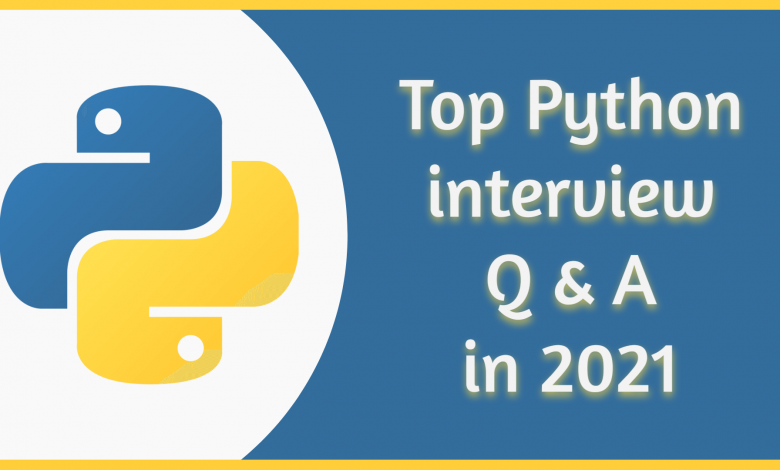Top 30 Python Interview Questions & Answers

Python is one of today’s most popular and sought-after programming languages. This object-oriented language is used by major businesses throughout the world to create programs and applications.
We’ve covered all of the most regularly requested basic and intermediate Python programming questions in this list of Python interview questions, along with extensive solutions to help you breeze through the employment interview.
Here are some of the most common and important Python programming interview questions and answers:
What is Python?
Python is a programming language that has objects, modules, threads, exceptions, and memory management that is automated. Python has the advantages of being simple and easy to use, portable, extendable, with a built-in data structure, and open-source.
What are the benefits of using Python?
- Its high-level data structures, along with dynamic type and dynamic binding, have attracted a large developer community for Rapid Application Development and deployment.
- Python is a general-purpose programming language with a simple, easy-to-learn syntax that prioritizes readability and hence lowers program maintenance costs. Furthermore, the language is scriptable, open-source, and enables third-party packages, which promotes modularity and code reuse.
What is pep 8?
PEP stands for Python Enhancement Proposal in Python. It’s a collection of guidelines for writing and designing Python code for optimal readability.
How is Python interpreted?
Python is an interpreted programming language. The Python source code is used to execute the application. It translates the programmer’s source code into an intermediate language, which is then translated into machine language, which must be executed.
What Is Pickling And Unpickling In Python?
Pickling is used as a serializing tool for objects. An object hierarchy is formed with the help of this technique. Unpickling is the reversal of the same process. When the hierarchy is removed for the python objects, it is referred to as unpickling.
Learn more : 70+ Top programming interview Questions & Answers.
What is PYTHONPATH?
PYTHONPATH has a similar purpose to PATH. This variable instructs Python Interpreter where to look for module files that have been imported into a program. It should contain the Python source library directory as well as the Python source code folders. Python Installer will occasionally set PYTHONPATH for you.
What Is A Python Module?
A module is nothing more than a code-containing file. It will include all of your code’s functions, classes, and objects. Within the file, all Python objects and data will have a scope.
What are Python decorators?
A Python decorator is a tweak to the Python syntax that allows us to quickly modify functions.
What is PyChecker?
PyChecker is a static code analysis tool that finds defects in Python source code and issues warnings about the bug’s style and complexity. Pylint is another tool that checks if a module complies with the coding standard.
What is Scope in Python?
In Python, a scope is a block of code in which an object is still relevant. All the objects in a program are uniquely identified by namespaces. These namespaces, on the other hand, have a scope set for them, allowing you to utilize their objects without any prefix. The following are a few instances of scope produced during Python code execution:
- Global scope: refers to the items that have been available since the beginning of the code execution.
- Local scope: refers to the accessible local objects in the current function.
- Module-level scope: refers to the program’s global objects that are linked to the current module.
- Outermost scope: refers to all of the program’s built-in names that may be called. To discover the name referenced, the items in this scope are searched last.
What are functions in Python?
A function is a chunk of code that is only executed when the function is called. The def keyword is used to specify a specific function.
What are generators in Python?
Generators are a method of implementing iterators. It’s a regular function with the exception that it returns expression in the function.
What Is A Map Function In Python?
A predefined function is map(). This allows the python objects to be executed in an iterative manner without the need of loops. The functional programming technique is represented by map(). It’s utilized when you need to apply a transformation function.
What is a dictionary in Python?
In Python, one of the available data types is the dictionary. It’s a jumble of components arranged in no particular sequence. In dictionaries, the items are kept as key–value pairs. Keys are used to index dictionaries.
What is docstring in Python?
Docstring is a Python documentation string that is used to document Python functions, modules, and classes.
What is pass in Python?
In Python, the pass keyword denotes a null operation. It is commonly used to fill in blank blocks of code that may execute during runtime but have not yet been written. We may encounter issues during code execution if we don’t use the pass statement in the following code.
In python What is the unittest?
Unittest is the name of a Python unit testing framework. It allows for setup sharing, automated testing, test shutdown code, and the grouping of tests into collections, among other features.
What is self in Python?
In Python, the term self is used to declare an instance of a class object. It is explicitly used as the first argument in Python, but it is optional in Java. It aids in the separation of a class’s methods and? properties from its local variables.
what are iterators?
Iterators are used to iterate a group of elements, such as a list, in Python.
Is indentation required in Python?
Every programming language has a mechanism for specifying the scope and extension of a code block. It’s called indentation in Python. Indentation improves the readability of the code, which is presumably why Python requires it.
What is negative index in Python?
Positive and negative integers can be used to index Python sequences. The first index in a positive index is 0, the second index is 1, and so on. The final index in the negative index is (-1), the second last index is (-2), and so on.
What Is The Purpose Of “End” In Python?
The print() function is followed by the end() function, which is a default function. Python 3 was used to implement it. It aids the Python interpreter in determining what should be displayed following the print function. end= “desired character” is the syntax. If the last character is a space, a space is inserted after the print function is run.
What is pandas?
Pandas is a free, open-source Python toolkit that provides data structures for data-related tasks such as data analysis and manipulation. Pandas fits in any function of data operation, whether it’s for developing different algorithms or addressing difficult business challenges, thanks to its extensive feature set. Pandas assists in dealing with a large number of files and executing actions on the data stored in them.
What do you understand by reindexing in pandas?
The process of conforming a dataframe to a new index with optional filling logic is known as reindexing. If the values in the preceding index are missing, the location is filled with NaN/NA. Unless a new index is created that is comparable to the present one, a new object is returned. False is assigned as the copy value. This is also used to change the dataframe’s row and column indexes.
What is regression?
Regression is a supervised machine learning algorithm approach for determining the relationship between variables and predicting the dependent variable (y) based on the independent variable (x). Prediction, time series modeling, forecasting, and understanding the causal-effect link between variables are all common applications.
What is SVM in Python?
The support vector machine (SVM) is a supervised machine learning model for two-group classification issues that takes into account classification techniques. The training data is represented as points in space that are sorted into groups with the assistance of a distinct separation that should be as large as feasible.
How Is Python Thread Safe?
When a thread cannot be modified regularly, it is considered to be in a safe condition. Python is unable to deploy more than one active thread at a time due to the GIL. It establishes a secure thread that can aid in processing.
Why is finalize used?
Before using the trash collection procedure, the finalize method is used to free up unmanaged resources and clean up. This aids in the execution of memory management operations.
Learn more: Top 30 Database interview question.
Define PIP
Python Installer Package (PIP) is an acronym for Python Installer Package. It is used to install various Python modules, as the name implies. It’s a command-line utility that creates a unified interface for installing various Python modules. It searches the internet for the package and installs it into the user’s working directory without requiring any human intervention.
Define GIL
Global Interpreter Lock (GIL) is an acronym for Global Interpreter Lock. This is a mutex that helps thread synchronization by preventing deadlocks by limiting access to Python objects. GIL assists with multitasking (and not parallel computing). GIL’s operation is depicted in the diagram below.
Three threads may be seen in the figure above. The GIL is acquired initially by the First Thread, which then begins the I/O execution. Thread 1 releases the acquired GIL when the I/O operations are completed, which is then picked up by the second thread. The process repeats itself, with the GIL being used by various threads in turn until all threads have fulfilled their tasks. Threads that do not have the GIL lock enter a waiting state and begin execution only when the lock is acquired.
